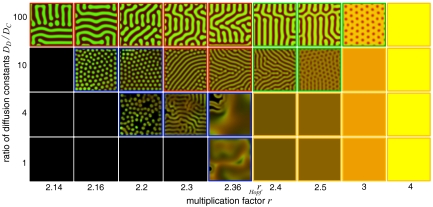Fig. 3.
Diversity of spatial distributions in terms of the ratio of the diffusion of defectors to cooperators DD/DC and the multiplication factor r in spatial ecological public-goods games. The brightness of the colors indicates the density of cooperators (green) and defectors (red). In the absence of space, the population survives for r > rHopf. If cooperator diffusion exceeds defector diffusion, DD/DC ≤ 1, the dynamics is barely affected by space, except for a small chaotic region (blue frame) near rHopf. The dynamics becomes much richer for DD/DC > 1. For r < rHopf, the chaotic regime increases (blue frame) and is replaced by diffusion induced coexistence patterns for high DD/DC (red frame). For r > rHopf, the homogeneous spatial distributions (orange frame) are replaced by diffusion-induced instability (Turing patterns; green frame) for high DD/DC. For very large r, all patterns disappear. The parameters are N = 8, c = 1, d = 1.2, b = 1, DC = 1, L = 283, dx = 1.4, dt = 0.1 (rHopf = 2.3658) and an initial configuration with random cooperator and defector densities in [0, 0.1]. For a detailed phase plane diagram and other initial configurations see SI Text and Figs. S1 and S5.

